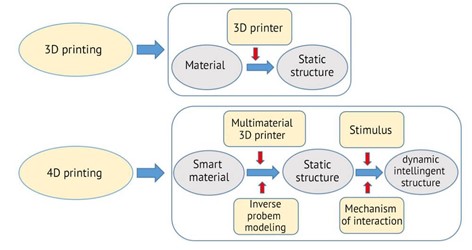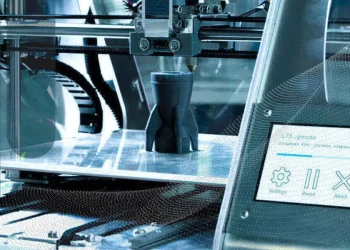Though still evolving, 4D printing technology may have the potential to play a transformative role in the industry with its ability to self-assemble / “shapeshift” objects based on temperature, light or other environmental stimuli.
Let’s walk down memory lane a bit. Nearly three decades ago as a young engineering student I was intrigued by the offer in a leading Science journal to send a tiny sliver of what they called a “shape memory alloy” to anyone who responded to a survey. They were talking about Nitinol – a Nickel-Titanium alloy that has the ability to return back to a preconfigured shape after being deformed. That was my first introduction to shapeshifting alloys.
Fast forward twenty years and 3D printing had become quite the buzzword. And I happened to be working at a pioneer in the print industry where the standard refrain was “Why are we not in the 3D print space?” And yes, they are making inroads into that space now, finally.
And here we are today whereas an Innovation and Thought Leader at a leading consulting firm I am looking with keen interest at an emerging technology – 4D Printing which combines the two strands from my past together and can have important ramifications in the Oil and Gas/Chemicals and other Resource-based industries (among others).
What is 4D Printing?
Well, to answer that, let’s start with 2D – a flat layer of anything with just two dimensions – length and breadth, is 2D.
In 3D printing, they keep on adding incremental layers of material along a specified print path in a process of additive manufacturing to essentially create a 3-dimensional object which now has volume: length, breadth (or width) and height (or depth).
In 4D manufacturing a fourth dimension – TIME is added to the 3-D printed object: you have a 3-D printed object which can change shape over time in response to external stimuli- temperature, light, etc.

Diagram adapted from [F. Momeni et al. / Materials and Design 122 (2017) 42–79], re-drawn by Jean-Claude André | Scientific Advisor at INSIS
A 4-D object is printed like any 3-D printed object but it is printed with materials that are “smart materials” – they like the shape memory alloys of yore have the ability to change shape and size based on certain environmental triggers. These are hydrogels or shape-memory polymers.
Where does 4D printing come from?
This technology largely comes from a project at the MIT Self-assembly Lab: “A research lab at MIT inventing self-assembly and programmable material technologies”.
Skylar Tebbits is often credited with creating the term 4-D Printing. Here’s an interesting Ted Talk by him on the “Emergence of 4-D Printing”
Here’s a video from the MIT Self Assembly Lab showing how a 4-D printed object changes shape to form another shape when placed in hot water.
This one about 4-D printed programmable wood is very interesting. The lab describes it as
“Flat sheets of the custom printed wood composite can be designed to self-transform in controlled and unique ways. While the lab has used water as a medium for activation, we imagine that we can also create wooden composites that radically adapt to extreme environmental conditions.”
What does this mean for the Industrial sector?
The videos and descriptions above are indicative of the kind of applications 4-D printing technology can be put to use for:
- Oil pipelines or any other fluid carrying pipelines that can dynamically change their diameter in response to the flow rate and demand.
- “Self- healing” pipes that could possibly heal themselves automatically if they crack or break. The change in pressure could be the environmental trigger for them to change shape to plug the leak.
- 4-D printed Valves that close or open in response to temperature or pressure of the fluid in the pipeline:
- 4D printed pneumatic flaps in engines that open and close automatically to control airflow.
- Self-assembling structures or components of oil rigs, chemical plants, buildings, bridges et al which would be cheaper and easier to transport in a flat state and can then reassemble in required shape at onsite. They could also have self-heal capabilities when impacted by adverse weather conditions.
- 4D printed spare parts can be more compact and easier to ship. They can take the desired shape when needed at the destination.
What Next?
4D printing is yet at a very nascent stage. But it would be important for the industry to keep in mind its potential impact when it moves beyond the R&D stage.
Brainstorming the current pain-points which can potentially be addressed by 4D Printing solutions could be a good starting point. Collaboration with research institutions and/or consultant partners to work on POCs or prototypes is another possible step (The US Army has for quite some time!).
Stay Tuned!
(The views expressed in this post are Deepak Seth’s own and do not necessarily represent those of his employer.)

Deepak Seth
Deepak Seth is Principal Director, Technology Consulting at Accenture. He provides Innovation and Thought Leadership as part of Accenture's CIO Advisory practice for clients in the Resources sector (Oil and Gas, Chemicals, Utilities, Minerals and Mining etc.). Prior to this Deepak has handled diverse and progressively increasing responsibilities at Xerox's IT organization. His last role was as Technology Strategy and Business Transformation leader for Solution Delivery and Acceleration. Deepak is a passionate advocate for innovation and adoption of Cloud solutions, AI/ML, API Microservices, predictive analytics, collaboration tools, blockchain, and other nascent/disruptive technologies into the enterprise to develop new opportunities and applications. Prior to Xerox, he has led several global initiatives for leading Corporations (including Bausch+Lomb, BlueCross BlueShield, Glaxo etc.). He has extensive experience in sales, finance and information technology in Asia, Africa and the Americas.








